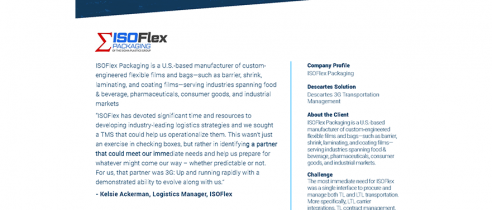Blog
Overcoming LTL Capacity with a Fully Connected TMS

Demand for trucking services has outpaced LTL capacity. Shippers are left searching for solutions. Read how 3Gtms can help solve LTL capacity issues.
There’s a hurdle in the road to recovery that the shipper community is still trying to overcome.
Analysts forecast the economy to grow dramatically in 2021’s second and third quarters. Consumerism is rising, domestic manufacturers have ramped up output, and ports on both coasts can’t keep up with swelling backlogs and imports. All this growth has caused a perfect storm where demand for trucking services is well-outpacing capacity.
According to Supply Chain Dive, spot load posts on the DAT load board were up nearly 130% from March 2021 compared to 2020 and, even more surprisingly, increased 232% from the same period in 2019.
Freight demand is expected to continue rising month-over-month for 2021 as it increased 3.4% from February to March, while trucking costs rose 6.5% over the same timeframe, according to Business Insider. To compound capacity issues further, FreightWaves said that carriers seem to be rejecting nearly 1-in-4 contracted tenders. In fact, FreightWaves reported that FedEx Freight cut service to 1,400 less-than-truckload (LTL) customers to reduce bottlenecks and shipping delays.
These increases in demand and prices leave shippers trying to come to grips with reality and forcing them to ask, “will there be enough trucking capacity to ultimately get my goods to market?”
It’s a hurdle most shippers never faced before.
For shippers who’ve already weathered everything that’s been thrown at them since early 2020, it can be distressing. We’re seemingly at an inflection point with public health and economic growth, yet shippers may not have the transportation available, especially at a reasonable cost, to actually reach their customers.
Typically less-than-truckload (LTL) carriers are used when parcel capacity is too low, and volume doesn’t quite demand full truckload. And that’s happening now as parcel carriers saw a 12.8% increase in their daily volume for Q1 2021 compared to Q1 2020. But the problem is that LTL carriers are already running at capacity. They’re maxed out. As a recent Journal of Commerce article stated, “everybody is slammed.”
This undoubtedly will translate to higher prices for shippers.
Just like we’ve seen with parcel carriers over the past year, LTL carriers likely will shy away from growing capacity. Instead, they’ll focus on boosting margins on the capacity they already have. Adding capacity is costly and mostly unrealistic right now. Truck backorders have mounted, with build slots nine months to a year out. And drivers might be harder to come by than trucks, especially for service-focused LTL fleets. Plus, adding capacity in ongoing market tumult is a risky endeavor.
Instead, LTL carriers are adjusting their rates and asking shippers to pay more. LTL carriers will also likely pull out of lanes they no longer want to service and focus on the lanes they like or are most profitable.
For buyers of LTL service, this means you have to be more dynamic and nimble in the way you work with your carriers.
So how can shippers overcome LTL capacity shortages? Upgrading their technology to a dynamic TMS that maximizes LTL options is one of the most actionable ways that shippers can manage their LTL transportation and work more efficiently with their carrier base.
Automatic rate shopping and mode optimization.
The beauty of a TMS is that it centralizes your rating into one platform where you can connect to your carriers, load boards, rate indexes, and more to maximize your number of contracted and spot rates.
In the coming months and years, shippers will need this functionality more than ever. Shippers want to rely on a TMS that does the rate shopping for them by finding the best transportation service at the lowest rates on the lanes they need. Every carrier is going to price lanes differently, and you want to use the right carrier in every lane for every shipment.
Also, as rates continue to climb in the coming months, shippers need a system that helps them shift modes, such as transitioning LTL shipments into multi-stop truckloads, for example.
The right TMS can handle all of those needs. Rate, route, and mode optimization — functions that used to be reserved for highly-skilled engineers — are now available to nearly any route planner and logistics manager.
Simplifying the complex.
Supply chains and freight transportation management have become immensely complex. Shippers need simpler. They need ease of use. They need something that takes the complexity and synthesizes it.
A dynamic TMS can do that.
Simpler doesn’t mean less functionality. It means software that’s easier to use, that takes care of shippers’ needs in a digestible way.
Technology that just a few short years ago seemed reserved for mega-shippers with IT and transportation budgets of hundreds of millions of dollars now makes sense for nearly all shippers using LTL or truckload transportation services. The right TMS takes the burden off internal logistics managers and lets them focus on what matters most — the art of delivery.
Providing needed competitive tools.
LTL and truckload carriers alike have invested billions collectively over the past half-decade in software that helps them calculate rates in real-time, so they can increase their prices quickly on a lane-by-lane basis to maximize their margins.
Shippers can’t afford not to keep up with those investments and the investments of their shipper peers, especially their competitors. It could mean the difference between riding the coming wave of growth into a more profitable tomorrow — or being left to continually struggle to find affordable trucking options.
Adoption is simpler than it’s ever been.
If you’re not using a dynamic, cloud-based TMS like 3Gtms, now’s the time to start investing in one.
Shippers that fail to digitize their transportation sourcing and management simply won’t keep up in the world of today, and more importantly, in the fast-approaching world of tomorrow.







